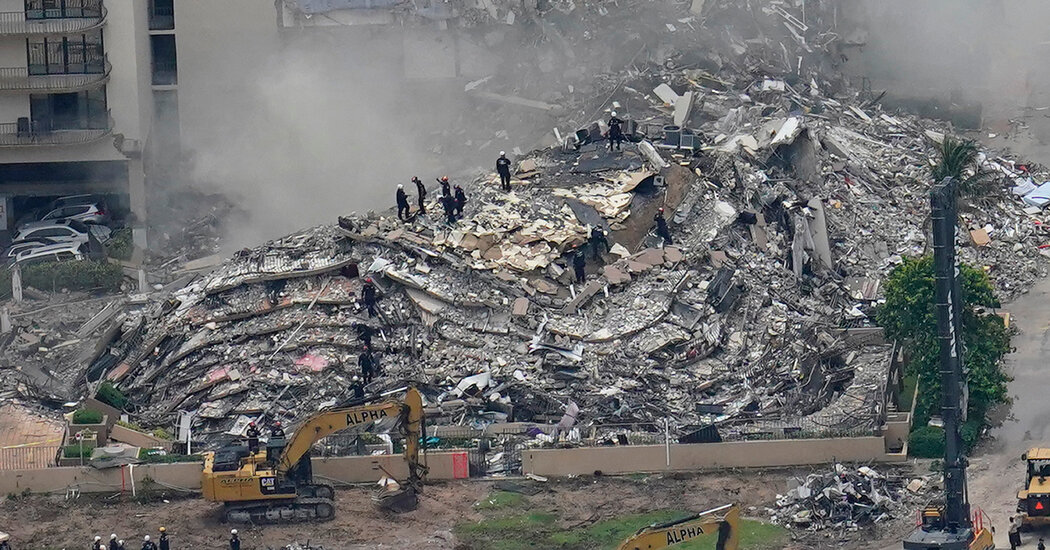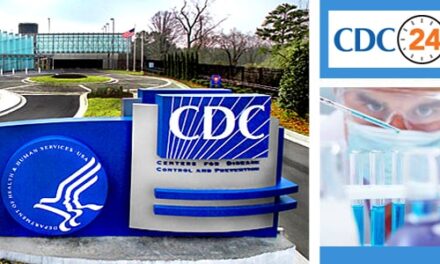
Officials ‘Still Have Hope’ of Survivors in Florida Condo Wreckage

Video
transcript
transcript
Rescue Efforts Continue After Florida Condo Collapse
At least four people were killed after a high-rise residential building collapsed near Miami Beach on Thursday. About 159 people remained unaccounted for on Friday afternoon.
-
Reporter: “Have you seen anything that leads you to believe there are still people alive there?” “We will continue search and rescue because we still have hope that we will find people alive.” “I was about to fall asleep when my wife and my kid, and my mom called me desperate, ‘Please, help me.’ I thought that it was a joke. Well, then I came running here and I’m trying to see what’s going on. And when I saw the building, I just couldn’t believe myself.”

Rescue workers continued Friday to comb through the rubble of the Champlain Towers South condominium in Surfside, Fla., just north of Miami Beach. But by afternoon, 159 people remained unaccounted for and four people confirmed dead, the same numbers officials had released early in the morning. No survivors had been found Friday.
“Speaking with a lot of these family members, when they’re unaccounted for, it’s a really, really difficult thing because they just don’t know,” Gov. Ron DeSantis of Florida said.
Officials continued to express hope that they would find survivors, but there was also a growing realization that time could be running short. Family members of the missing were asked to provide D.N.A. swabs in case it was needed to identify remains.
“My mind tells me there is no way she could have survived such a massive collapse, but I believe in a God that can do anything,” said Sally Noriega, whose 91-year-old mother-in-law, Hilda Noriega, lived in the building and has not been heard from.
President Biden said federal mortuary services would be available if needed, and Mayor Daniella Levine Cava of Miami-Dade County told CNN on Friday night that the county had just “received the president’s support for FEMA funding.”
In Friday morning, the mayor said that crews were doing everything they could to safely sift through the rubble for survivors.
“These first responders are going in through tunnels, they’re working from the top, they’re working from the bottom,” Ms. Levine Cava said. “It has to be done very, very carefully. They can’t dislodge pieces of debris that could injure them in the process. They can’t dislodge debris that could possibly make it more difficult to continue the search.”
An official with the Miami-Dade County Medical Examiner Department said Friday that Stacie Fang, 54, died in the collapse. Ms. Fang was rescued from the rubble but pronounced dead at a hospital. She is the first victim to be identified by the medical examiner. Ms. Fang was the mother of Jonah Handler, a 15-year-old boy pulled from the rubble on Thursday in a dramatic rescue, the authorities said.
“We could see his arms sticking out and his fingers wiggling,” said Nicholas Balboa, 31, who was walking near Champlain Towers when he saw the building collapse. “He was just saying, ‘Please don’t leave me. Please don’t leave me.’”
The stunning collapse of the residential building, in the beachfront town of Surfside, left few answers and considerable questions about how a 40-year-old condo building could have suddenly crumbled as residents rested in their beds.
The 13-story structure, with more than 130 units, was home to a mix of retirees and well-off professionals with young families. The wrecked interiors of what were once people’s homes gaped open toward the ocean: Broken air-conditioning units. An empty bunk bed. Linens waving in the wind.
“The collapse stopped right at our apartment,” said Marian Smeraldi-Lopez, who said she escaped from the sixth floor on the partly collapsed building’s stairway. “No apartments on that north side were visible. Just air, debris and rubble.”
A lawyer for the resident-led association that manages Champlain Towers said the building had been about to undergo extensive repairs for rusted steel and damaged concrete.
Mr. DeSantis and Ms. Levine Cava pledged to investigate the causes of the collapse.
“We all want answers; we all need answers,” Ms. Levine Cava said. “We never want this to happen again.”

The first victim of the Florida condo collapse to be identified is Stacie Fang, 54, the authorities said.
Her son, Jonah Handler, 15, was pulled alive from the rubble on Thursday in a dramatic rescue.
Ms. Fang was also pulled from the wreckage but pronounced dead on Thursday at Aventura Hospital and Medical Center, a spokesperson for the Miami-Dade Medical Examiner Department said on Friday.
The cause of her death was blunt force trauma, the medical examiners said.
“There are no words to describe the tragic loss of our beloved Stacie,” the Fang and Handler families said in a statement posted on Twitter by a local TV reporter.
According to Ms. Fang’s LinkedIn page, she worked since 2009 as a vice president for a company that organizes an annual event for retail marketers. She studied business administration and management at Pace University in New York, and graduated in 1990.
Ms. Fang’s sister, Virginia Borges, arrived at the reunification center for victims’ families on Thursday afternoon. Ms. Borges told The Washington Post before authorities confirmed her sister’s death that her nephew had not been badly injured.
“He wants to know what happened to his mother,” Ms. Borges said. “We all want to know.”
Video of Jonah’s rescue shows emergency workers hoisting him out of the wreckage and strapping him to a stretcher.
Nicholas Balboa, 31, said he was walking near Champlain Towers when he saw the building collapse and heard a boy calling for help.
“We could see his arms sticking out and his fingers wiggling,” Mr. Balboa said. “He was just saying, ‘Please don’t leave me. Please don’t leave me.’”
The boy said his mother had been with him, but Mr. Balboa heard no other voices. Using his cellphone flashlight, Mr. Balboa flagged a police officer, who rushed toward them with a rescue crew. The crew dug through debris and used a saw to get the boy out, Mr. Balboa said.
Jonah Handler plays baseball for Monsignor Edward Pace High School in Miami Gardens, according to his scouting page. The Archdiocese of Miami said that he was in his sophomore year.
“On behalf of Stacie’s son, Jonah, we ask you now to please respect our privacy to grieve and to try to help each other heal,” the Fang and Handler families said in their statement.
— Alyssa Lukpat

SURFSIDE, Fla. — After a thunderclap of noise jolted Bruno Treptow awake on Thursday morning, he rushed to open the front door of his eighth-floor condo. He then realized something terrible, he said: “The hallway’s gone.”
Where there had been a row of doors opening into different neighbors’ apartments, there was now a void of dust and breeze. The “beautiful family” with two young daughters in 802; the young married couple in 804; the single father in 801 who coached his son’s baseball team. In an instant, the apartments were gone, the fate of their occupants uncertain.
“I knew them all,” said Mr. Treptow, 62, who had lived in the building for 20 years.
They made up an only-in-Miami mix of residents at the Champlain Towers South condominium — beach-seeking retirees from New York, striving young families, Orthodox Jews and well-connected South American immigrants, drawn to the 13-story building by its palmy beachfront setting in this 5,600-person town just north of Miami Beach.
Family members of the 159 people who remained unaccounted for after the tower collapsed waited anxiously for news on Friday, praying and updating far-flung relatives as they fought to hope for miraculous rescues against the hardening realization that they might never see their loved ones alive again.
“I hang onto the hope that she’s in there,” said Stephanie Fonte, whose vivacious, fashion-loving sister, Cassondra Billedeau-Stratton, 40, was among the missing. “If there’s any way possible, she’s going to fight this. But the longer time goes by, the more we begin to lose hope.”
Ms. Fonte said her sister had lived in the building for about six years, going back and forth between Miami and Colorado, where her husband works as a political strategist. She loved the pool, and walking and biking along the beach. She also loved photography, and when the sisters were together, Ms. Billedeau-Stratton would often make them stop and pose in front of a special spot on the beach or near a burst of flowers.
Ms. Fonte said her sister had been talking on the phone with her husband at around 1:30 a.m. on Thursday, moments before the collapse: “She said the building was shaking and then the phone died,” Ms. Fonte said.
Another one of the people missing in the wreckage was Manuel LaFont, 54, a businessman who worked with Latin American companies and the father of a 10-year-old son and 13-year-old daughter, according to his ex-wife, Adriana LaFont.
Ms. LaFont described Mr. LaFont as a loving and devoted father who ate, drank and slept baseball — a passion he had inherited from his Cuban parents. Mr. LaFont had played the sport in his youth and coached his son’s team, never missing a practice or a game.
“He’s the best dad,” Ms. LaFont said. “He’s the most genuine person I ever met.”
Their children were with Ms. LaFont, who lives elsewhere, when the building collapsed, and the three of them sat together praying and waiting for news. Faith was vital to Mr. LaFont, she said, and, late on Thursday night, the family was not ready to give up their hopes.
“He was,” Ms. LaFont said at one point as she described Mr. LaFont. She then stopped to correct her tenses: “He is.”

Engineering and architectural experts said that it might take a long time to piece together what caused the partial collapse of the condo building near Miami, but that there weare a few things that investigators would look for: corroded components, an undermined foundation or defects in the construction or design.
“When a building falls downward on itself it’s more likely that there was a loss of support somewhere,” said Abieyuwa Aghayere, a professor of civil, architectural and environmental engineering at Drexel University.
The Champlain Towers South building in Surfside, Fla., was about to undergo extensive repairs for corrosion and concrete spalling, or flaking, as part of a required structural recertification for buildings when they reach 40 years of age. Ocean salts can penetrate structures and begin rusting steel components, in particular rebar that may be improperly protected.
But there are other factors that could make a building vulnerable to collapse. Charlie Danger, who retired as Miami-Dade County’s building chief seven years ago, said unauthorized remodeling could result in someone eliminating a structural support column.
In addition, some experts, including Mr. Aghayere, said a sinkhole or other problems with a foundation could lead to major instability under a building.
Gov. Ron DeSantis of Florida and Mayor Daniella Levine Cava of Miami-Dade County both promised on Friday that there would be a full investigation of the collapse.
“We need a definitive explanation for how this could have happened,” Mr. DeSantis said.
Federal investigators were dispatched to the scene. The National Institute of Standards and Technology, which investigated the collapse of the World Trade Center on 9/11, sent a team of experts to Florida on Friday afternoon to meet with local building officials and engineers.
The federal team will ask about the design of the building, how it may have been modified and what happened before the collapse, according to Sissy Nikolaou, an expert on geotechnical engineering who is part of the group. She said she expects the team’s first visit to last about a week.
“We have to understand the landscape of a disaster,” Dr. Nikolaou said in an interview.
Researchers using space-based radar to examine the flooding potential in the Miami Beach area had noticed long before the collapse that the Champlain Towers South building was subsiding, or on land that was sinking, in ways that neighboring properties were not.
“I was surprised,” said Shimon Wdowinski, an environmental professor at Florida International University. “I didn’t expect to see movement over there. That’s a stable part of the city.”
But Mr. Wdowinski said other areas with even larger amounts of subsidence are often seen in areas that have not had buildings collapse.
There have been other complaints from residents of the Champlain Towers condominium complex. One resident filed a lawsuit over water intrusion that she blamed on poor maintenance. Others complained that nearby construction had sent rumbles through the structure.

Dozens of volunteers flowed into The Shul, an Orthodox synagogue just up the road from the site of the Champlain Towers building collapse, on Friday morning. Offering to do, well, anything, they were mostly put to work organizing massive piles of donated items that have also streamed in since word of the condo collapse spread.
A mound of pillows 12 feet high. Hundreds, maybe thousands of bottles of water. A space on one table in the synagogue’s social hall labeled “Wipes.” Another labeled “Shaving.” A third labeled “Feminine Hygiene.”
The volunteers — mostly 20-somethings, but there were elementary school students and older adults, as well — were tasked with sorting clothes and boxing them up, first by gender and then by size, to make it easier for survivors to come in and grab what they need.
“Something like this happens in the community and you just have to rise up, and help,” said Ilene Weinkle, who was pitching in. She works at a Jewish day school for children with special needs.
Ultimately, The Shul’s social hall couldn’t accommodate more donations and incoming items were sent to a local kosher food bank — which soon became full, too. Volunteers were looking for another location.
Israel’s consul general in Miami, Maor Elbaz-Starinsky, visited The Shul mid-morning to offer his support. He had been awake for 30 hours, and mostly at the scene. “Not that I’m clearing rubble,” he said, “but I do think I have to stand by this wounded community.”
The Israeli search-and-rescue team is on standby to come and help if asked, Mr. Elbaz-Starinsky added. The country’s government is making sure that those with relatives who lived in the Champlain Towers are able to board flights to the United States.
The Israeli minister of diaspora affairs, Nachman Shai, is expected to visit the area on Sunday.
— Neil Reisner
-

Octavio Jones/Reuters
-

David Santiago/Miami Herald, via Associated Press
-

Joe Raedle/Getty Images
-

Octavio Jones/Reuters
-

Lynne Sladky/Associated Press
-

Miami-Dade Fire Rescue/via Reuters
-

Saul Martinez for The New York Times
At the site of the partially collapsed Champlain Towers South condominiums in Surfside, Fla., on Friday, emergency crews surveyed the damaged, worked to put out fires and searched for survivors. Family members of those missing embraced as they waited for any news.
— The New York Times

As emergency medical workers kept up their frenetic search for the missing in the flattened rubble in Surfside, Fla., on Friday, they relied on some lessons of past disasters and on the grim but increasingly sophisticated science of urban search and rescue.
Michael J. Fagel, an emergency planner, was a scene-safety and logistics officer after both the bombing of the Alfred P. Murrah Federal Building in Oklahoma City in 1995 and the attacks on the World Trade Center on Sept. 11, 2001. He recalled not the noise of the piles, but the silence — the life-or-death importance of utter silence.
“We used stethoscopes. We used hearing devices,” Mr. Fagel, 68, said of the Oklahoma City disaster site. “We would actually stop the mission for five minutes. You’d have three blasts of an air horn. And you would listen. You hear a moan. You hear a whisper. You hear a breathing sound.”
Mr. Fagel, who teaches disaster management, said the search-and-rescue effort in Florida will most likely use some of the same techniques that have guided the response to building collapses and explosions in past decades.
The scene will probably be broken up into zones for easier organization of personnel and in an attempt to instill order. A priority is to cut the utilities, a complex task.
“You may have to go in the street with a backhoe, dig them up, shut them down so you have no more spark, no more potential fuel for the fire,” he said.
There are multiple operations at once, and some move more quickly than others. There are those studying the safety of the scene itself and working to stabilize sections of the building still standing. An acronym soup of local, state and federal agencies and officials assemble, including the task forces that make up the Federal Emergency Management Agency’s National Urban Search and Rescue Response System.
The difficulty for those focusing on the rubble comes in working quickly yet methodically.
“You may remember when you were growing up, there was a game called pick-up sticks,” Mr. Fagel said. “If you pull out something from the debris pile, it may cause a structural shift two floors away.”
And despite all the training and the military-style command structure, each search-and-rescue effort improvises its way through problems.
In July 1981, a dance was being held in the lobby of a Hyatt Regency in Kansas City, Mo., when elevated walkways suspended from the ceiling collapsed, killing 114 people.
As rescuers converged on the scene in Kansas City, streams of water began flooding the lobby. The flow came from water tanks that could not be shut off, and trapped survivors were at risk of drowning. When the fire chief discovered that the hotel’s front doors were keeping the water inside, he called in a bulldozer.
“You use every tool, every faculty, because we are still people helping people,” Mr. Fagel said. “That’s all it is.”
He said some of those searching through the rubble on Friday will remember the work for the rest of their lives. Mr. Fagel, who became ill from working at ground zero on Sept. 11, said the mental and physical effects may not be evident for years.
“I had colleagues of mine who worked the Oklahoma City bombing who would not go back through downtown at Sixth and Harvey,” he said. “They would avoid it. They’d drive around it.
“We as responders put ourselves before others. But we as responders forget that we’re human.”

Sergio Barth, the owner of a youth soccer academy in the Miami area, said Friday that he believed his older brother Luis Barth, 51, a lawyer visiting Florida from Medellín, Colombia, was in the building when it fell, along with Luis’s wife, Catalina Gomez, and their daughter Valeria, 14.
Luis and his family had traveled to South Florida for a number of reasons, Sergio said: They wanted to get the family together after the coronavirus had prohibited family members from traveling internationally, and they wanted to spend some time on vacation. Luis and his family had also decided to get vaccinated in the U.S., given the frustratingly slow pace of the vaccine rollout in Colombia.
Image
The family arrived in Florida on May 25, Sergio said, and all three of them got the vaccine. In the last few days they were in nearby Port St. Lucie, where Valeria was enrolled at a tennis academy. Their plan was to go to Miami on Thursday and briefly stay in a friend’s condominium in Champlain Towers before moving to Sergio’s house and continuing their vacation. Luis and Sergio’s mother had flown up from Colombia on Monday, and Sergio’s nine-year old daughter was eager to see her older cousin.
But for some reason, Sergio said, Luis, Catalina and Valeria went to Miami a day earlier than planned. “That’s a God thing,” Sergio said. “It’s really hard for us to understand and explain.”
Sergio said he had been calling the family’s cellphones, but no one answers. The loss — if it is indeed a loss — will be felt intimately and broadly. Luis was politically active in Colombia — his brother described him as a practical-minded centrist — and he had formerly served as director of the Medellinnovation District, a technology and innovation hub central to the city’s effort to move beyond the years of drug-war violence.
Catalina was also a talented lawyer, Sergio said.
But Sergio was also contemplating the loss of a brother 10 years his senior who had stepped into a paternal role when their father died in 2001.
“I don’t know what to think,” Sergio said in an interview Friday morning. “I mean there is, I think, resignation here, with just a little, little, little esperanza — you know, hope. Miracles happen. So until the authorities say the investigation is closed we have to keep thinking positive.”

When did it happen?
Survivors said they were jolted awake at about 1:30 a.m. on Thursday by fire alarms, falling debris and the feeling of the ground trembling.
How many people have died?
At least four people were killed. The authorities fear many more fatalities.
How many are unaccounted for?
As many as 159 people were unaccounted for as of Friday afternoon, officials said. The authorities have stressed that the numbers continued to shift as the authorities figure out how many people were actually in the building.
How many have been rescued?
About 35 people were rescued from the intact part of the building, and two were pulled from the rubble, said Ray Jadallah, a Miami-Dade Fire Rescue assistant fire chief.
How tall was the building?
The tower was 13 stories tall; about half of the 135 units collapsed.
When was it built?
It was constructed in 1981, according to county property records.
How many people live in Surfside, Fla.?
The town, just north of Miami Beach, has about 5,600 residents.

CAIRO — Around the world, buildings often collapse because of sloppy construction, poor maintenance or the use of low-quality concrete and other building materials. But the bigger problem is weak, uneven or nonexistent oversight; local authorities may fail to enforce building standards, lack the power to do so, or take bribes to look the other way.
Shoddy construction is widespread in poor and informal settlements in Egypt, for instance, where it is not uncommon for small residential buildings to collapse.
Even a quick review of building collapses around the world in recent years shows the same problems again and again: people building illegally or without the right construction permits, or developers adding more floors than the structural supports were designed to hold in a bid for bigger profits. Such structures are easy prey for a fire, earthquake, gas explosion or bad weather, but sometimes a collapse has no obvious cause.
In the United States and other developed countries, however, building regulations tend to be tighter and better enforced — though experts agree that American infrastructure is a different story, with bridges and roads in urgent need of updates.
“In most developed countries, the construction of any building is highly controlled, so both the design and the approval process and the inspection of the building during construction — all of that is done, and therefore you have very few failures,” said Matthys Levy, a structural engineer and the author of “Why Buildings Fall Down.”

A partial collapse of the Champlain Towers South building killed at least four people on Thursday and forced dozens of others from their homes in the middle of the night with virtually nothing. More than 100 people remained unaccounted for on Friday.
Today, many are searching for ways they can help. The mayor of Miami-Dade County, Daniella Levine Cava, said on Friday that local charities had seen an influx of goods and urged people to donate money instead.
“We have received all of the donations of goods and volunteers that we can handle at this time,” she said. She announced the creation of Support Surfside, a hardship fund. It was established in collaboration with Coral Gables Community Foundation, The Miami Foundation, the Miami Heat basketball team and others.
Ryan Logan, with the American Red Cross, echoed that sentiment on Friday. “We have the supplies we need to help these people,” he said, asking people to donate money to the Support Surfside fund.
The mayor also cited a fund established by The Shul of Bal Harbour, a synagogue, which has already seen more than $450,000 donated. The money will be dispersed directly to the victims and families.
Other charities coordinating donations include the Greater Miami Jewish Federation, which opened an emergency assistance fund. The federation will also provide crisis counseling, social services and more.
The United Way of Miami-Dade has set up Operation Helping Hands to support and assist affected families with both short and long-term needs.
GoFundMe has also created a list of verified fund-raisers for the cause.
Source: https://www.nytimes.com/live/2021/06/25/us/miami-beach-building-collapse/
















